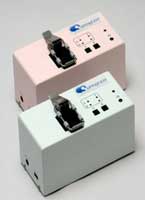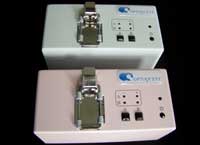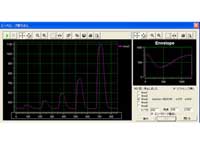Web Japan > Trends in Japan > Sci-tech > New Tool Against Food Poisoning
New Tool Against Food Poisoning
Miniature Device Detects Bacteria in Minutes
A start-up company in Japan has succeeded in developing an inexpensive miniature device that detects and evaluates substances in solution. Optoquest Co., Ltd., an optical equipment manufacturer based in the city of Ageo in Saitama Prefecture, will begin selling its SPR-M1 model miniature detection device in October 2008. One of the applications of the device is the quick detection of food poisoning bacteria, making it a potential life saver in schools and hospitals.
How Surface Plasmon Resonance Works
SPR stands for surface plasmon resonance, a term that refers to the vibration of electrons on a metal surface. When light is reflected, under certain conditions a portion of the light penetrates to the other side of the reflective surface. The light that penetrates is called evanescent light. When surface plasmons and evanescent light occur in close proximity and have the same wave number, surface plasmon resonance occurs.
The SPR-M1 takes advantage of this phenomenon. The solution being tested is received by the device on a thin film of metal (gold), beneath which is a glass prism. Light produced by a light-emitting diode is brought to a focus by a pair of lenses and shone on the prism at a certain angle. This causes plasmons to appear on the surface of the metal and evanescent light to occur inside the metal, and the result is surface plasmon resonance. This resonance has the effect of changing the concentration of the light reflected from the metal surface, and the distribution of this concentration varies according to the type and density of substances contained in the solution. A sensor measures this concentration, and the results are quantified by computer to provide an evaluation of the types and densities of the substances in the solution.
Making it Small and Inexpensive
There are already a number of products available that operate on the same principle employed by the SPR-M1; they are used for analyzing proteins, among other things. The larger ones are about the size of a microwave oven, and the smaller ones are as big as a toaster. They are also expensive—a complete system costs well over $100,000. By contrast, the SPR-M1 is only 10.5 centimeters wide, 5 centimeters tall, and 5 centimeters deep and weighs a mere 300 grams. Furthermore, this device is far less expensive than previous comparable products: the price of a single unit is less than ¥1,800,000 (about $16,350 at ¥110 to the dollar).
According to an Optoquest representative, the company succeeded in producing such a small and inexpensive device by eliminating unnecessary functions and taking advantage of Optoquest's superior optical equipment manufacturing technology. In principle, the sensor chip incorporating the thin metal film in devices like this is replaced each time a different solution is tested. Each chip used in previous products cost hundreds of dollars, but the chips used in the SPR-M1 cost less than $100 each, greatly reducing running costs.
Previous such products were designed as stationary devices for indoor use, but the SPR-M1 can easily be carried around. In addition to providing its portability, it can be powered either by batteries or an AC power source. Moreover, the user can input reference values into the device in advance, making it possible to evaluate a solution without using a computer. These properties give the SPR-M1 a wide range of applications. The device will, for example, make it possible to conduct a three-minute test for the presence of food-poisoning bacteria in school or hospital meals. (October 2008)




